The Impact of Political Change on Mortgage Rates and Housing Market Dynamics

The recent political landscape in the United States has significantly influenced economic indicators, particularly in the housing sector. Following the victory of President-elect Donald Trump, the U.S. 10-year Treasury yield experienced a notable increase, and mortgage rates began to follow suit. This article delves into the ramifications of these shifts, examining the broader implications for consumers, the housing stock market, and the future of housing policies.
Mortgage rates have been a critical concern for prospective homebuyers. As reported by Mortgage News Daily, the average rate on a 30-year fixed mortgage climbed 9 basis points to 7.13%, marking the highest since early July. Initially, analysts predicted a sharper increase in rates following the election results, but the actual changes, though significant, did not reach those expectations. Matthew Graham, COO of Mortgage News Daily, noted that bond traders entered the election with the anticipation that a Trump victory would spur higher rates—a sentiment confirmed by the immediate adjustments in financial markets.
Every percentage point increase in mortgage rates can substantially affect monthly payments and overall affordability for homebuyers. For instance, a $400,000 home with a 20% down payment would have seen monthly payments swell from $1,941 at September’s low rates to $2,157, a staggering difference of $216. This rise has undoubtedly made homeownership feel less attainable for many Americans and is likely to deter potential buyers already facing affordability challenges in a volatile market.
The stock market’s reaction to rising mortgage rates is equally telling. Major housing stocks, including those of prominent builders such as Lennar, D.R. Horton, and PulteGroup, saw declines of approximately 5% in midday trading after the election results. Analysts like John Burns, CEO of John Burns Real Estate Consulting, point out that builder stocks are particularly sensitive to shifts in mortgage rates and expectations about future rates. Many of these large builders have been actively working to buy down mortgage rates to maintain customer interest, a strategy that unfortunately compresses their profit margins.
Retailers that cater to home improvement needs, such as Home Depot and Lowe’s, also felt the negative impacts of rising rates, with shares dropping around 3% each. The correlation is clear, as higher mortgage rates can dampen home sales, thereby affecting sales for companies tied to new home constructions and renovations.
Despite fluctuations in mortgage rates, the housing market has recently seen an uptick in activity. October data illustrated a remarkable 29.2% increase in homes actively for sale when compared to the prior year, reaching levels unseen since December 2019. This increase can be attributed to a growing supply of homes entering the market as builders respond to demand, even amidst rising borrowing costs. The National Association of Realtors reported a 7% rise in pending home sales in September, indicating a momentary burst of confidence in the market before rates peaked sharply.
While discussions around deregulation and the potential opening of federal lands for housing development emerged as themes in Trump’s electoral campaign, detailed strategies remain vague. The National Association of Home Builders has expressed optimism about collaborating with the new administration but concrete plans are yet to materialize.
As we gaze into the future of the housing market, significant uncertainties remain. The interplay between inflation, economic performance, and governmental policy decisions will ultimately shape the trajectory of homeownership and mortgage rates. Graham concluded that “the path ahead is anyone’s guess,” pointing to the unpredictable nature of governmental action and macroeconomic factors.
The recent political shifts have created ripples through the housing market, driving up mortgage rates and impacting housing-related stocks. As we navigate this evolving landscape, stakeholders from consumers to policymakers must remain vigilant to adapt to changing financial realities. The commitment to affordability and accessibility in housing will be critical in sustaining homeownership aspirations for millions of Americans.





